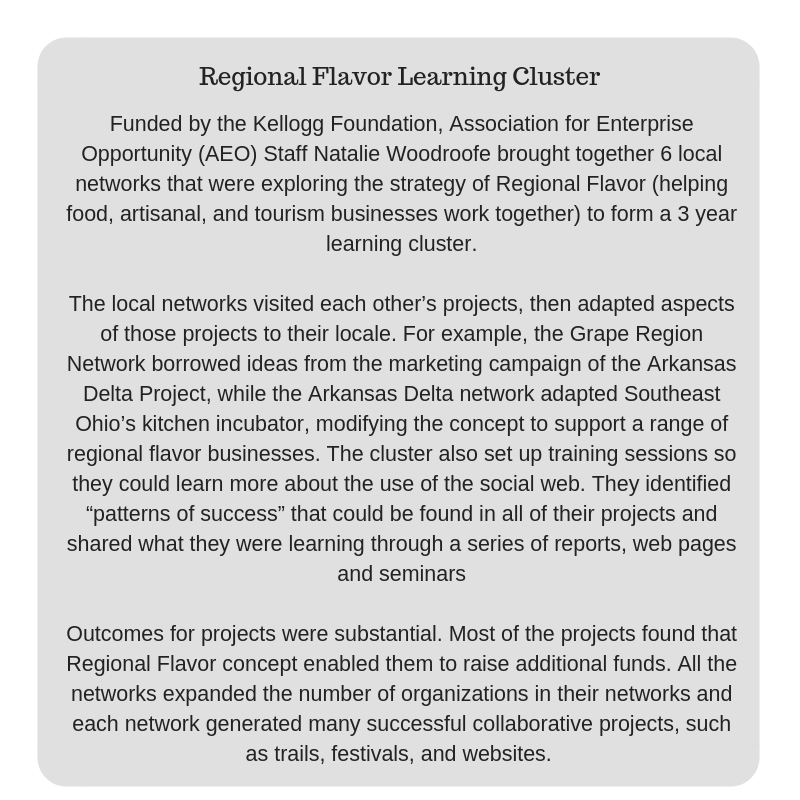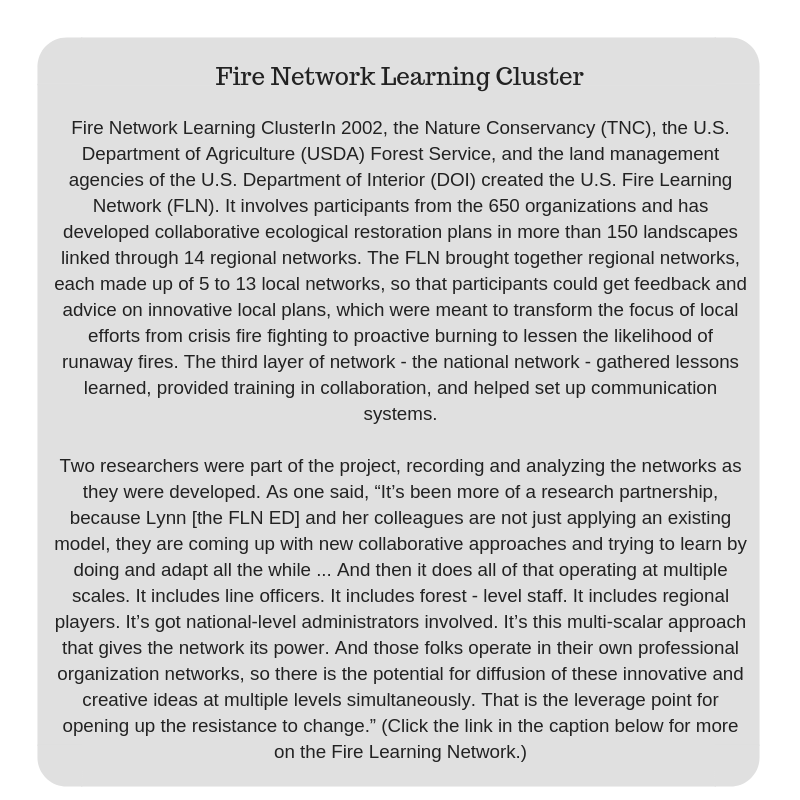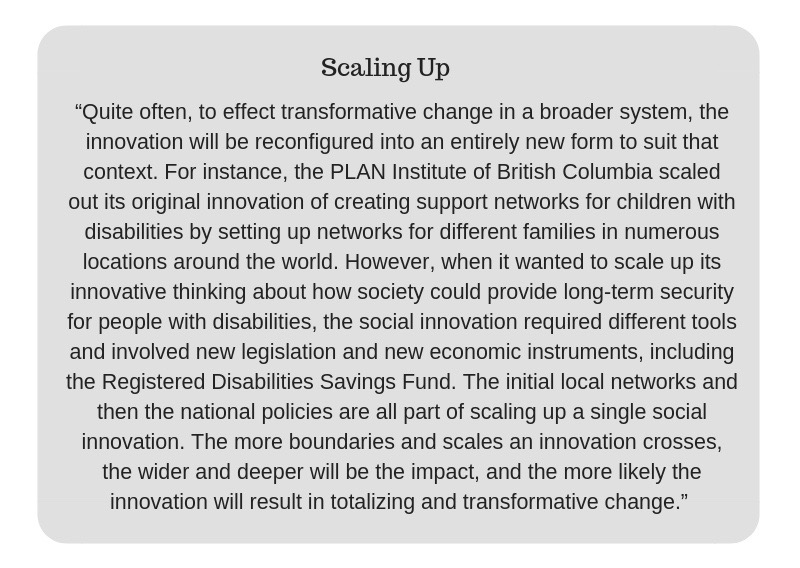Transformative Networks Are Multiscalar
[ap_spacing spacing_height="30px"]
This is an excerpt from the Network Weaver Handbook. I'll be writing an update with my latest research and thinking on the topic in the coming weeks so stay tuned! - June Holley
[ap_spacing spacing_height="25px"]
How does transformation of our systems happen?
In the 1950s, researchers developed a model of the diffusion of innovation where, when influential individuals adopted an innovation, that practice or idea would spread rapidly among the rest of the population. In this model – still favored by many marketing strategists – all you had to do was to identify influential individuals, convince them that your product was superior, and their influence would ensure that many other people adopted your product. The adoption of the use of hybrid seed corn in the 1950s and the fad of hula hoops were touted as successful examples of this type of innovation diffusion.
"The critical question is whether an how social networks can help facilitate innovation to bridge the seemingly insurmountable chasms that separate local solutions from broad system transformation."
- Michele - Lee Monroe and Frances Westley
More recently, Duncan Watts, a researcher in the area of complex networks, refuted this simple approach to the diffusion of innovation. He showed that whether an idea or practice is spread by an influential person is highly probabilistic – sometimes spread happens and sometimes it does not. Spread depends much more on the kind of network surrounding the innovation than on the kind of individual advocating an innovation. For example, if networks bridge across clusters so that there is now a larger network, innovations can flow to a larger set of practitioners. Also, networks where people are working in many projects, each with somewhat different participants, are likely to see innovations spread quickly. When a useful innovation arises in one project, the individuals in that project are likely to tell all their other projects about the innovation.
"Scale the edge, not the core."
"Building on this, we have discovered that creating multiscalar networks – networks that cross levels or layers – are what turns innovation into widespread systemic transformation. We have identified specific patterns of 3 layers of interconnected networks that can bring about this transformative effect. People working in an issue or vision area need to make sure that they are part of all three if they want maximum impact.
- Level 1: Build local networks for experimentation
- Level 2: Build networks for scaling out so that local innovations can spread, inspire, and learn from others
- Level 3: Build networks for scaling up so infrastructure and policy to support innovations can be developed
LEVEL 1: Local Innovation Networks to experiment
"Scaling across happens when people create something locally and inspire others who carry the idea home and develop it in their own unique way."
-Margaret Wheatley, Walk Out Walk On
Chapter 10 described the process for creating a maximally innovative local network. However, there are two additional aspects of local networks that enable them to effectively link to networks at other scales:
- Development of an effective periphery for spreading ideas
- Expansion or spread of local networks for increased impact
The phrase, “Scale the edge, not the core,” describes the importance of developing an extensive periphery for your local network. Much of that periphery will be located outside of the local community. People in the periphery who help the local network be maximally innovative are:
- People in other communities around the world working in the same issue or vision area who can offer new ideas and practices
- People in other communities who are interested in what the local community is doing
- People who are connected to other disciplines or sectors and might have new insights or identify ways the two sectors could combine efforts
Another aspect of local innovation networks is that they encourage local groups to obtain a more sophisticated understanding of the entire system that their issue is embedded in and encourages them to work with others to address issues systematically. So, for example, a network working on prison reform might start to work with jobs programs and entrepreneurship organizations to develop better re-entry programs and, at the same time, work with a community development network on ending racism-related sentencing.
Many local food system networks have joined with artisan organizations and other local businesses to create healthy local economy initiatives. Other local food system networks have expanded their network to include those working on anti-obesity efforts. Transformation begins as projects increasing connect with projects working on other aspects of the system, thus amplifying their impact. Other fields (immigrant reform, criminal justice, reproductive rights, poverty, etc.) could all benefit from this type of local expansion of their networks.
Activity: Expanding your local innovation network
On chart paper or large whiteboard, have people in your network identify organizations and individuals they could add to their periphery to access new ideas. Then, using another color have them identify organizations that are interested in their local experimentation and with whom they might share what they are learning. Identify individuals in the local network who will seek out and/or stay in touch with each.
Using another color, identify local organizations from somewhat different fields but interested in some of the same problems or issues with which they might have discussions on how they could work together. Determine which are the highest priority. Who will reach out to them?
LEVEL 2: Scaling out networks
"Information can leap from group to group even when those groups seem to have nothing in common, because all they need in common is a single individual who is member of both groups and therefore has a bridging identity."
-Paul Hartzog
In the 20th century, many foundations funded efforts to replicate best practices. We know now that replication is an inadequate concept for the complexity of social problems we are working with for three reasons:
- Most projects need to be adapted to each specific community to be fully effective.
- Most projects can still be improved and so shouldn’t be replicated slavishly.
- Specific projects are still only one piece of a very complex problem or system and without integrating a number of system elements at the same time project success is likely to be limited.
Still, there is a lot of great experimentation happening in communities. For other communities to benefit from this requires a scaling out network. A scaling out network has four different aspects
- Support the spread of innovations
- Develop systems for determining which local efforts are worth scaling
- Support learning clusters of organizations working on similar strategies
- Support rhizomatic acceleration: research, venues, and leadership for scaling out
1. Scaling out by supporting spread
People in local networks need to be encouraged to share information about their innovations wherever they go. Funders need to provide incentives for successful innovative projects to coach other communities as they adapt that innovation (see the Saving for Change example below). Funders might have grantees suggest groups/networks they want to learn from, then help these identified innovators set up training sessions, site visits, or coaching.
Actually much informal sharing is already occurring, and it would be valuable to identify groups or individuals who have been very successful at informal sharing and document their methods and practices through case studies.
One of the best ways for people to learn about innovations is through stories about those innovations. The success of the RE-AMP case study by the Monitor Institute shows that there is a huge need and market for high-quality case studies. In fact, it would be great to have web sites where sets of case studies were collected, along with notes from conversations people had with each project so that a deeper and more complex perspective is available. People need to be able to take a “deeper dive” into the case study by asking questions of those involved in the innovative project or network. If such sites also had discussion forums, then we would be able to easily see which projects appeared to be attracting a lot of attention and funders could direct more resources to those innovators
2. Scaling Out By Developing a System for Identifying Projects for Scaling
Not all projects are worth scaling. How can projects be evaluated to help others determine whether they are effective? Initially, promising projects may not show clear outcomes but will have deeply embedded processes for reflection and learning that will enable them to continue modifying their approach until it produces results.
We need Network Guardians who are exploring issue areas at a meta-level, identifying projects that are tackling similar problems but using different approaches and noticing those projects that, in addition to showing early promise, appear to have a lot of energy and attraction.
The United Nations (cited in Critical Choices by Reinicke and Deng) calls this role a network entrepreneur. A network entrepreneur identifies niches where conditions are right for launching new global public policy networks and takes steps to initiate formation of a new network. Foundations and national networks could also help identify areas where scaling could be most beneficial. BALLE is an example of a national network that is identifying a variety of innovations that can fill the need for local access to local capital for local businesses.

3. Scaling Out Through National Learning Clusters
Learning clusters are one of the most underused and underfunded strategies for scaling projects. They are the second level in a multi\scalar network and critical for transformation. A learning cluster is a set of local network projects from different communities whose participants are brought together regularly (virtually and/or face-to-face) to share about strategies they have developed, build skills, and learn from each other. It is through intensive reflection by these initiatives that key leverage points for system change can be identified for an entire issue area.
Clusters can be composed of innovative network projects that are already underway or of local networks just embarking on a strategy (or, ideally, mixtures of both). In most cases, each project will be unique: variations among the strategies, in fact, are encouraged so that participants can continually learn from each other.
Three critical ingredients of learning clusters are:
- Highly skilled facilitation
- Attention to building deep network relationships among the participants
- Diverse participants from each participating local network (different types of organizations, individuals of different ages and backgrounds)
In learning clusters, projects are introduced to the innovations of other groups, and at the same time, the cluster as a whole looks for the critical elements among all their projects that lead to success. Clusters can provide peer assists (sessions where one project outlines a challenge and the other projects ask questions, give ideas and advice, and share information about resources). Each local group also gets assistance from the rest of the cluster as they adapt model projects from other cluster members to their particular locale. The entire group also provides support for each local project as it continually improves and refines its strategy.

Many learning clusters that have been set up by funders have not been successful because the local projects have not been the initiators of the convenings and have not been able to have a say in the selection of their learning partners. Learning clusters take surprisingly few resources to operate, but dissemination of findings to larger groups in the field and handbooks that capture the cluster’s recommendations on implementation both need to be part of the overall project.
Activity: Create A Learning Cluster
- Identify 6 to 12 organizations working in your issue area that you would like to learn more about.
- Have sets of twosies in your network, select an organization each to call and interview.
- Identify the ones that are most innovative. Find out if they would be interested in being part of a learning network.
- Identify a source of funds to support coordination of the learning clusters.
4. Scaling out by supporting Rhizomatic Acceleration: Research, venues, and leadership for continued scaling out:
The concept of rhizomatic acceleration is key to successful scaling out. When we study a ginger rhizome we learn that every bud of ginger has the nutrients to generate and support many other buds. As a result, ginger rhizomes can expand rapidly without any central authority (see photograph below).
How do we implement a rhizomatic approach?
- We ensure that all Network Weavers learn how to help others become Network Weavers.
- We make sure that individuals who are part of collaborative projects are made aware of the skills, processes, and platforms that are being used in that project, and are encouraged to use these in other projects of which they are a part.
- We make sure that network participants have many platforms and venues for sharing what they are doing in ways that others can adapt their innovations.
In addition, research teams (including practitioner and professional researchers) using a developmental evaluation approach need to be embedded in learning clusters from the start so that they can record what is happening transparently and as the learning cluster is unfolding. Developmental evaluation uses a complexity lens to understand what is being developed through innovative engagement.
By sharing information and insights as the learning cluster progresses, other local networks can be adapting what is learned in their locale even before the learning cluster has concluded. Webinars, gatherings that piggyback on conferences, and interactive websites – all can become venues for sharing out what is learned in the clusters.
In addition, participants in the first learning cluster could then become coaches and trainers in a second, larger learning cluster. In this way, learning clusters become rhizomatic accelerators to the extent that the initial participants become skilled at and willing to share what they have learned with other local networks.
Like ginger, where every node has the nutrients to support the budding off of many other nodules, learning cluster participants need to be encouraged and incentivized to help many others adapt their strategies (see Michael Quinn Patton’s Developmental Evaluation

[ap_spacing spacing_height="40px"]
LEVEL 3: Scaling Up
Transformation is unlikely to occur simply by having many communities adopt innovations. Not enough communities will find out about the innovation, not enough resources will be available even for those communities that do want to adopt innovation, and not enough connections among the innovations will occur for a tipping point to be reached. In addition to scaling out innovations, scaling up mechanisms need to be set in place.
Scaling up is the use of policy, platforms, strategy, and meta-networks to accelerate the spread of innovation. Scaling up has typically been accomplished by control-based mechanisms. Often corporations scale up by creating franchises (think McDonalds) where each local fast food restaurant is identical to every other unit – with all units controlled by a central office. This method of scaling up can produce rapid growth and substantial profits, but has resulted in many unintended consequences such as our current obesity epidemic with its horrific impact on quality of life and skyrocketing medical costs.
Another example is the No Child Left Behind legislation which mandated a system of testing for school children and led to “teaching for the test.” This policy required all schools to operate in this way and is an example of scaling up through control and homogeneity. The problem with this path to scaling up is that mandated policies don’t always accomplish their intended goals – as has recently been shown by the flat test scores for all grades. When this happens, our entire society suffers. “One size fits all” policies are seldom successful for issues as complex as education, since students and their communities vary so greatly that a single policy is unlikely to work everywhere.
Network systems offer a healthier and more useful model for scaling up, especially in situations where we are grappling with complex problems and systems: Regional or national meta-networks. A meta-network is a network of local or regional networks. Such networks enable rapid scaling up through the use of:
- System analysis for identification of leverage points
- Network Guardians
- Clustering into working groups or action groups to focus on leverage points
- Pooled funds
- Communication platforms
- Policy networks
The time is right for the formation of more intentional meta-networks for many issue areas. We now have enough experience with networks so that we can create structures that are likely to succeed, and the potential to increase impact is great.
Support for meta-networks
Scaling up is best accomplished through regional, national or international meta-networks that focus on a particular issue, problem, or system development area. Meta-networks can either be formally organized, as in the case of RE-AMP, or informally organized, as is the national network focused on supporting local food systems.
Informal Meta-Networks
In an informal meta-network, an organization or set of organizations playing the Network Guardian role identify innovations, convene learning clusters around those innovations and access resources for organizations/local networks in the clusters, and then share out the learnings generated by the cluster. They set up funding pools to support the expanding numbers of local networks implementing this innovation and connect sets of learning clusters, each working on different aspects of the system, so that the entire system begins to shift.
As learning clusters unfold, they identify key system elements for success of that strategy and will come up against barriers that will need to be addressed. Many of these elements would be better implemented by a regional or national program requiring new policy to be enacted. An informal meta-network encourages the formation of policy networks to move support for innovations from foundations to government.
For example, the local PLAN networks, described below, discovered that to fully support people with disabilities, they needed to work together to develop a national program that enabled these individuals to save money for a home, education, or a business (without jeopardizing benefits). This required policy networks to be formed to set in place the necessary legislation.

https://www.ecologyandsociety.org/vol16/iss1/art5/
Formal meta-networks networks
More formally organized networks such as RE-AMP set up networks with more explicit structures to help organize work. They have membership and formal structures – such as the Working Groups that RE-AMP set up – to organize the work. They have a set of platforms and venues for sharing information, from an interactive website to regular Working Group calls.

